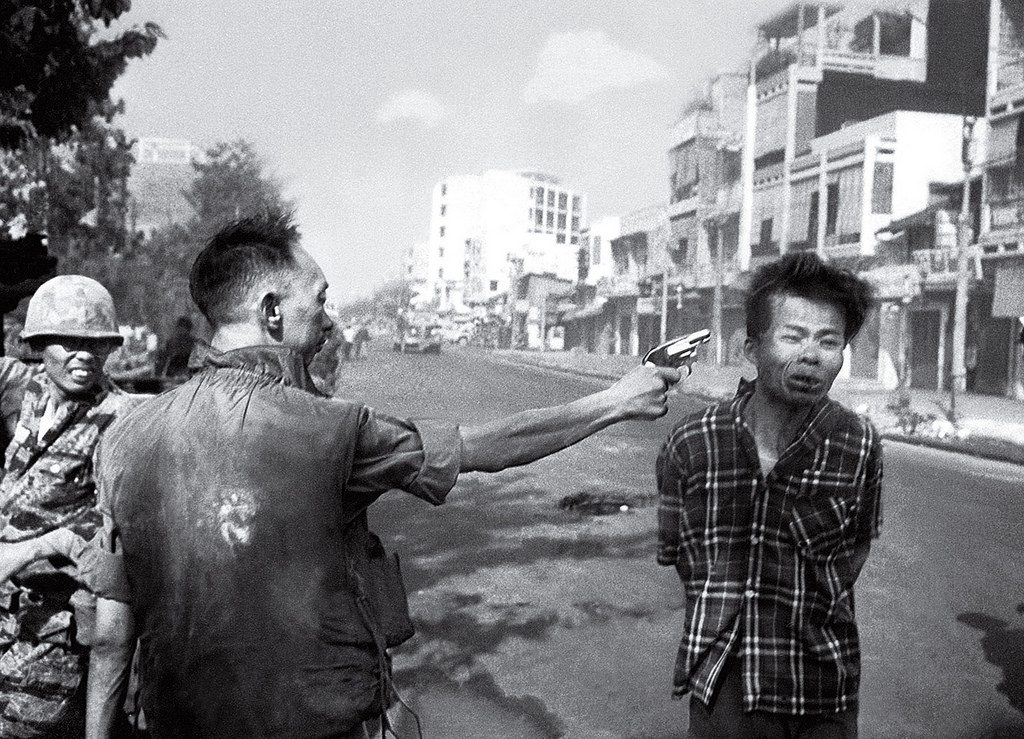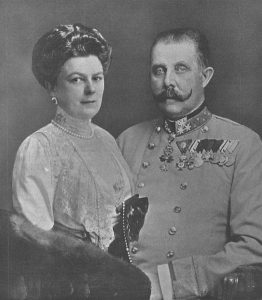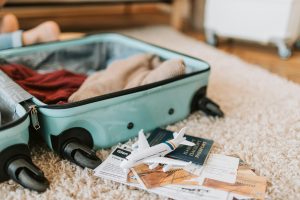Winner of the Fall 2018 StMU History Media Award for
Article with the Best Use of Images
Article with the Best Introduction
The year was 1968. The month of January was almost over and “Tet,” the Vietnamese Lunar New Year, was about to begin. By now, Vietnam had been embroiled for years in a civil war. North Vietnam was under the leadership of a Communist government and South Vietnam was under the leadership of a government that was backed by West. The start of Tet in 1968 was used to launch a huge offensive by the Vietcong in which coordinated attacks took place all over South Vietnam to destabilize the region and push the United States to withdraw.1
The United States‘ intervention in Vietnam began in 1965, a year after the unwarranted attacks by North Vietnam on United States‘ Destroyer ships in the Gulf of Tonkin. By 1967, the number of American troops on the ground surged.2 Despite being involved in this conflict halfway across the globe, the war did not seem so distant with the steady stream of footage and photographs from the front-lines directly to living rooms all over America. In this regard, Vietnam was unique for being one of the first wars to be filmed and photographed extensively.3 The work done by journalists in Vietnam allowed the world to see what was happening in Vietnam firsthand. Among those in Vietnam documenting the war was Eddie Adams.
Eddie Adams had been involved with photography since an early age. He had been a photographer for his high school newspaper and had done some photography work for weddings. Upon graduating high school, he enlisted in the United States Marine Corp. As a Marine, Adams served as a combat photographer in Korea for almost 3 years. In 1965, in what he describes as an “alcoholic haze,” Adams and a close friend decided they would go to Vietnam to document the war.4 During his time in Vietnam is when Adams took the photograph of the Saigon execution.
The day Adams shot the picture featured above was February 1st. He recalls himself and NBC journalists heading toward Cholon, a section of the city of Saigon, because they heard of a battle taking place there. Adams came upon South Vietnamese Brigadier General Nguyen Ngoc Loan executing a Vietcong soldier, in cold blood, in broad day light, in the middle of the street. Adams recalls himself and the other journalist gathering around Loan as he grabbed the soldier. Adams assumed Loan was only going to threaten the man. In the instant Adams raised his camera to snap a photo, Loan raised his pistol and executed the soldier. Loan explained after, that the Vietcong soldier had killed many Americans and allied Vietnamese soldiers.5
The photograph showed up on all major news evening broadcasts and on the front cover of newspapers all over the world the next morning.6 The execution was also recorded, but the specific angle Adams got in his photograph showed the war in an indescribable way. Peter Braestrup, one of the most versed individuals on the Tet offensive, described the picture as a “kind of ultimate horror story that you captured in living color. But in terms of information it told you almost nothing.”7 His quote could not do more justice. What the world saw was a man who was wincing before certain death. They did not know the man was a part of the Vietcong. In the photograph, he seems to be wearing civilian clothes which misleads one. The man had also recently killed allied soldiers and was found armed during martial law- an offense that justifies the use of force.8 Eddie Adams believed he had done an injustice to Loan. He explained, “General Loan was our guy. We were supporting him… believe me, the Americans did just as bad things. I just happened to see this and shoot it…”9

Despite the Johnson Administration’s attempt to win public support of the war, the images of the war painted a very different picture. Public opinion felt that the war was no longer winnable, rather it was now a matter of how America could save face. Walter Cronkite, a well-respected news-anchor and a strong supporter for the war, was among those whose opinion shifted. It was reported that President Johnson believed “if I lost Cronkite, I’ve lost America.”10 The irony of it all was that the Tet Offensive was largely a failure for the Vietcong in terms of land gained and damage inflicted, but in the end its psychological impact on how Americans believed the war to be going, led to its success.11

While this photo was taken out of context, it did provide small truths of the war. Although the war was going well, horrendous acts were being committed. Eddie Adams and many others were able to expose the world to the atrocious acts being committed during the war. Nick Ut’s photo of a napalm strike on a village, is another photo that came to define the war. Ut’s photograph captured the moment children run away in horror from napalm strikes on their village.12 The shattered innocence and utter despair on the childrens’ faces while soldiers seem calm provides a stark incomprehensible contrast that pulls at the heart. These photographs captured only instances of the war. But in the frozen state of a photograph, one is able to examine and reexamine a photograph and truly take in all its details. There was no propaganda campaign that could ever keep a just people supporting a war when they saw photographs like these.

As journalist, Adams and the others were simply doing their jobs. Horst Faas explained about documenting the war, “I don’t think we influenced the war… [he believed simply that the job of journalist was to] record the suffering, the emotions and the sacrifices of both the Americans and the Vietnamese…”13 Their work allowed for the false reality America was living to fall apart. As Americans lived, worked, and played, the very basic rights all humans are entitled to were violated by both sides. As such, Americans responded. In 1973, with public support overwhelmingly against the war in Vietnam, the United States signed the Paris Agreement that led to the withdrawal of all American troops.14 The involvement of the United States in Vietnam continues to be synonymous with some of the most appalling violations of human rights, not only violations against Vietnamese civilians burned alive with napalm or killed slowly through cancer with massive exposure to Agent Orange, but also of the atrocities committed or witnessed by US forces. In addition, all US Soldiers exposed to Agent Orange in indirect ways as when combat medics who worked at Clark Air Force Base (Philippines Islands) received the US soldiers injured in Vietnam who had been evacuated by air. These combat medics received soldiers injured in the field in Vietnam covered in Agent Orange with no protocol for decontamination for the injured nor for themselves as medical personnel. Fifty years on and they continue to die from cancers caused by exposure to Agent Orange. While the US left in 1973, the human suffering due to human rights violations done then, continues today. These images changed the public opinion and changed the course of history even when they may have not saved all those involved at the time, they avoided even greater damages and loss of life, for that we are grateful to these powerful images.
- Patrick Hagopian, America in the World, 1776 to the Present: A Supplement to the Dictionary of American History (Farmington Hills, MI: Charles Scribner’s Sons, 2016), 752. ↵
- James H. Willbanks, Vietnam War: A Topical Exploration and Primary Source Collection (Santa Barbara, CA: ABC-CLIO, 2017), 133, 183. ↵
- James H. Willbanks, The Tet Offensive: A Concise History (New York: Columbia University Press, 2007), 5-6. ↵
- Encyclopedia of World Biography, 2nd Edition, s.v. “Eddie Adams” (Detroit: Gale, 2005), 4. ↵
- Encyclopedia of World Biography, 2nd Edition, s.v. “Eddie Adams” (Detroit: Gale, 2005), 4. ↵
- David Culbert, Television’s Visual Impact on Decision-Making in the USA, 1968: The Tet Offensive and Chicago’s Democratic National Convention, Journal of Contemporary History Vol. 33 (1998): 421. ↵
- David Culbert, Television’s Visual Impact on Decision-Making in the USA, 1968: The Tet Offensive and Chicago’s Democratic National Convention, Journal of Contemporary History Vol. 33 (1998): 424. ↵
- David Culbert, Television’s Visual Impact on Decision-Making in the USA, 1968: The Tet Offensive and Chicago’s Democratic National Convention, Journal of Contemporary History Vol. 33 (1998): 423, 426-428 ↵
- Encyclopedia of World Biography, 2nd Edition, s.v. “Eddie Adams” (Detroit: Gale, 2005), 4-5. ↵
- James H. Willbanks, Vietnam War: A Topical Exploration and Primary Source Collection (Santa Barbara, CA: ABC-CLIO, 2017), 255. ↵
- James H. Willbanks, Vietnam War: A Topical Exploration and Primary Source Collection (Santa Barbara, CA: ABC-CLIO, 2017), 249 ↵
- Hal Buell, The Napalm Girl, Vietnam 25, no. 1 (June 2012), 36-39. ↵
- Deborah Stadler, Frontline Focus, Military History 33, no. 6 (March 2017), 56-61. ↵
- “12 Address to the Nation Announcing Conclusion of an Agreement on Ending the War and Restoring Peace in Vietnam. January 23, 1973.” 2001. American Reference Library – Primary Source Documents, (January, 1.) ↵



188 comments
Lynsey Mott
Its incredible what a photo can do; in the case it ends a war. Wars are a waste of everyone’s time, energy and resources. The only people who want to start wars are those who see a good thing and want to ruin it. Photos remind us what is good, and what was bad so that we don’t have to repeat our mistakes. These pictures are really horrifying especially the first one because you can see the anguish on the mans face and the determination on the soldiers face that he will shoot and ask questions later.
Donte Joseph
I remember reading about this article a while ago and truthfully, I am not surprised that it was nominated. The pictures used were very well with and powerful. When looking at this article as a whole, it is really well written, and the pictures are essentially the cherry on top. I am just glad that there are photos that are able to recount the incident that happened for historical purposes.
Roman Olivera
This article really does use great images. The truth about war is ugly and the photography from this war really showed that. America was so misinformed about what was going on in other countries with our troops and what the people from those countries were doing to each other. I believe that many lives were saved by these photos and the truth coming out in the media. This was an impressive article, congratulations on your nomination.
Jasmine Rocha
This article was nominated for the use of the best use of images. The image in this article is what drives the article and brings out the message of the article. The article also contains other images that show different views of what was going on during the Vietnam War. The image was not selected for the beauty of the image but for how it helped end the Vietnam War because of the horrifying truth of what was going on.
Alexandria Zapata
I remember learning all about the Vietnam War in high school history, and it’s sad to hear about it. It was interesting to read about the photographer, and his early life a little bit. He, and many others, “exposed to the world… the atrocious acts being committed during the war”. The majority of the picture are really heartbreaking to look at.
Emily Jensen
Congratulations on having your article nominated! I remember reading this article earlier in the semester, but It was nice to have another go at it. A picture really is worth a thousand words, an effective mode of communication. The pictures are horrifying and heartbreaking to look at, certainly a key player in the anti-war propaganda of the late 20th century.
William Ward
The saying “every picture is worth a thousand words” is proven with this great article. The majority of pictures taken during times of war are more than enough to discourage the youth from ever wishing for conflict on the scale of war. This article relays a great story about a picture that is a saddening as the story behind it. Great article and was a great read.
Enrique Segovia
Congratulations Jose Sanchez for your nomination in the category for Best Use of images (featured image as well as text images)! In fact, this article had my favorite pictures -taking into account their impact on society. Eddie Adams’ picture saved the life of possibly millions of American and Vietnamese fighters in the extensive war. Impressively, an image had a major impact and even stopped a war.
Brianna Ford
What really caught my eye in the articles was the use of photographs they expressed much more than words can, You really put the phrase “A picture is worth a thousand words” to action. Over all this was a very informative and interesting article and it allowed me to learn more about the Vietnam war. It is so heartbreaking that the people in Vietnam had to suffer so much, I hope this never happens again and peace is brought back to the world.
Mariah Garcia
This article was extremely well-written! The Vietnam war was truly something horrific in the history of both our nation and Vietnam. The people of Vietnam suffered a lot, and to see this represented within one picture, to see this encapsulated in one picture is truly moving. Unnerving almost, this picture reminds me of the vulture stocking the child, a picture wherein there is a vulture stocking a child who appears to be moments away from death; the photographer won a Pulitzer, I believe, then went on to commit suicide over their lack of action in regards to that photo.